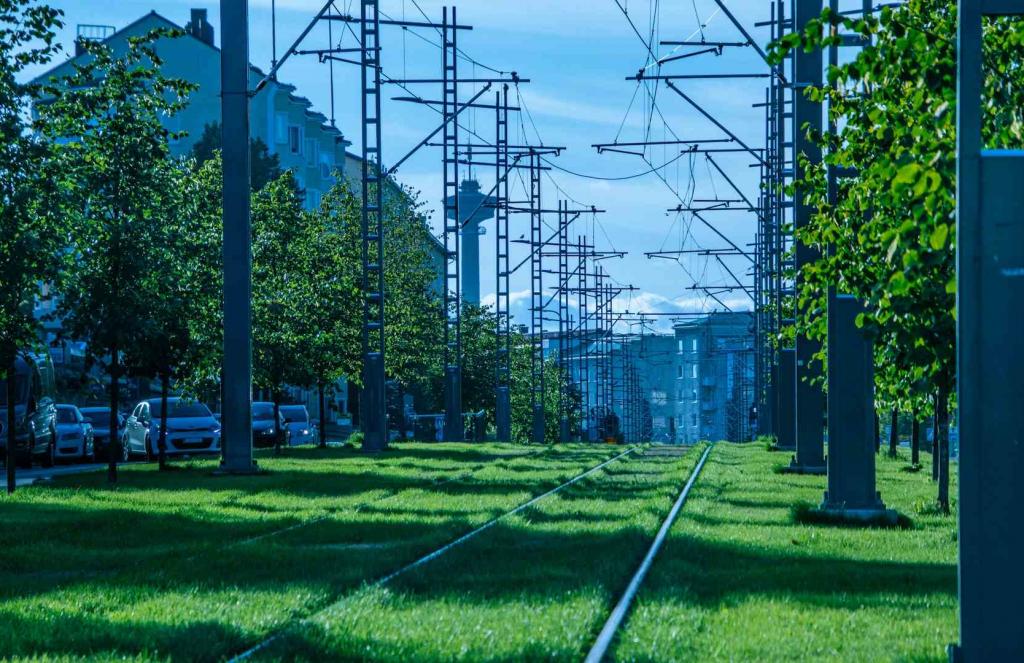Thessaloniki gets ready for its metro launch in November
The underground rapid transit lines have been under construction for almost two decades due to various project delays
 TheMayor.EU logo
TheMayor.EU logo 
Green tracks have been around since 1924, though they have only been gaining popularity in cities recently, Source: Juho Luomala / Unsplash
The city will re-do 9 kilometres of tram tracks by introducing more efficient greenery and decarbonised construction methods
Last Friday, Vienna authorities announced a new project for creating more resistant and climate-effective green tram lines by using succulents instead of grass. Additionally, Wiener Linen, the municipality’s tram management company, will also use several new methods to decarbonise the reconstruction process.
Both projects will be part of a 37-million-euro investment into the city’s tram network. Vienna has among the best tram networks in the world. It is a central point in the local plans for lowering travel emissions, both for moving people through the city, but also, recently, moving parcels on their last-mile journeys.
Grassed tram tracks have been around for a long time, first introduced in 1924 in Liverpool, although for much of their existence, they have been mostly a stable of rural rails. In recent years, however, they have started gaining popularity in cities, as local authorities around Europe try to increase the amount of green space in cities.
The most common coverage for green tracks is rolled turf designed to provide a high vegetation performance for 3 to 5 years on average. During that time, the turf should be maintained as normal grass areas in an urban environment, including cutting and watering.
Green tracks offer a host of benefits for the urban environment, as they absorb sound and cool temperatures down. However, due to the fact that they require a lot of maintenance and water, they are also somewhat inefficient.
Sedum, on the other hand, offers a solution to this problem, as it is a more resilient plant, due to the fact that it is a succulent. This means that it needs less soil, less water and can handle being stepped on. As an official statement of the city points out, a sedum track is a place where ambulances can drive on in emergencies, as opposed to a grass track.
Wiener Linen will use sedum on a test track, with the evaluation period set until 2023. Consequently, by 2024, the city could start expanding the sedum sections to cover more and more of the tram lines.
One of the sites during the redevelopment process will try to combine a host of new techniques to examine the viability of carbon-neutral construction. Instead of having a catch-all solution, Wiener Linen will try and implement a range of solutions for the different moving parts.
For example, the site will only use electric machines, that will be powered by 100% renewable energy. Authorities have said that they want to go even further in the future by generating all the energy they need on-site. Additionally, they will use recycled concrete, wherever possible.
Are you between 15 and 29 years old? Take a moment to complete a short survey on youth empowerment on this link.

The underground rapid transit lines have been under construction for almost two decades due to various project delays

Now you can get your wine in Talence by paying directly in Bitcoin

That’s because the state has to spend money on updating the railway infrastructure rather than subsidizing the cost of the popular pass

Rethinking renewable energy sources for the urban landscape

The examples, compiled by Beyond Fossil Fuels, can inform and inspire communities and entrepreneurs that still feel trepidation at the prospect of energy transition

Now you can get your wine in Talence by paying directly in Bitcoin

The 10th European Conference on Sustainable Cities and Towns (ESCT) sets the stage for stronger cooperation between the EU, national and local level to fast track Europe's transition to climate neutrality.

At least, that’s the promise made by the mayor of Paris, Anne Hidalgo

The underground rapid transit lines have been under construction for almost two decades due to various project delays

At least, that’s the promise made by the mayor of Paris, Anne Hidalgo

Hostal de Pinós is located in the geographical centre of the autonomous region

Despite its church-y name, the district has long been known as the hangout spot for the artsy crowds

Urban dwellers across the EU are having a say in making their surroundings friendlier to people and the environment.

Forests in the EU can help green the European construction industry and bolster a continent-wide push for architectural improvements.

Apply by 10 November and do your part for the transformation of European public spaces

An interview with the Mayor of a Polish city that seeks to reinvent itself

An interview with the newly elected ICLEI President and Mayor of Malmö

A conversation with the Mayor of Lisbon about the spirit and dimensions of innovation present in the Portuguese capital














